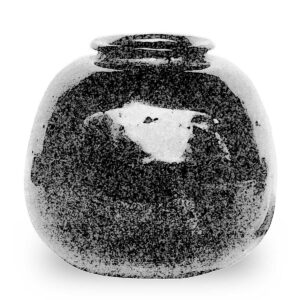
A type of karamono small jar tea caddy. The name comes from its resemblance to an eggplant. In ancient times, it was called “Nasubi” and now it is called “Nasu”. Because of the small number of eggplant tea containers, they were placed at the top of tea containers, with the eggplants being ranked as the “heavenly children” and the shoulder implements as the “shoguns”.
The eggplant seems to have been originally a Chinese oil jar. Later Japanese oil vases are also eggplant-shaped. The overall shape is less curvaceous than that of a hijapu, i.e., it has no kuchizukuri, no kurigae, no steamer, no shoulders, etc. However, the line of the bulging body is reminiscent of a jewel, which may be considered more interesting to appreciate than that of a hijapu. In the old days, only eggplants were used for true tray setting, but since the time of Rikyu, it has been abbreviated to hagajime, bunrin, enjyubou, and shirifuki. The following are famous eggplant tea containers made by Han. Kunishi, Kitano, Fuji, Matsumoto, Sogo, Tane, Akebono, Akaneya, Fukuhara, Tanabata Kyogoku, Miojyo, Shaogu, Bungo Rikyu small, Kiba Saru, Sakuromono, and Shujari. (“Chakki Bengokushu,” “Chayiri-no-Yokichi,” “Chado Meibutsu Kou.”)



